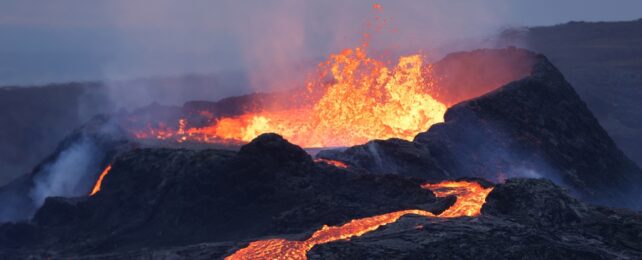A town in Iceland, home to 4,000 people, could be devastated by an imminent volcanic eruption, experts said.
Grindavik, which is close to the capital Reykjavik, could sustain heavy damage within hours or days, per The Guardian.
"The magma is now at a very shallow depth, so we're expecting an eruption within a couple of hours at the shortest, but at least within a couple of days," Vidir Reynisson, head of Iceland's Civil Protection and Emergency Management, said on Saturday.
Iceland has declared a state of emergency as up to 2,000 earthquakes — 1,000 overnight Saturday alone, according to the Icelandic Met Office — struck the southwestern Reykjanes peninsula, signaling an increased risk of a volcanic eruption.
In response to the heightened seismic activity, the Blue Lagoon, renowned for its geothermal spas and luxury hotels near Grindavik, was closed as a precaution.
The Department of Civil Protection and Emergency Management announced the state of emergency, citing the intense earthquake activity at Sundhnjukagigar, north of Grindavik.
It is not possible to save livestock and farm animals from the defined danger zone due to the landslides in Reykjanes, per the Department. The area is currently closed to all human traffic, until further notice.
The Icelandic Met Office (IMO) has warned that an eruption could occur "in several days," heightening concerns. Grindavik, situated just 1.86 miles southwest of the seismic epicenter, has activated evacuation plans in anticipation of a potential eruption.
Two substantial earthquakes, with a magnitude of 5.2 north of Grindavik, were felt as far as the capital, Reykjavik, and along the country's southern coast, causing widespread shaking and damage. The Icelandic police closed a key north-south road to Grindavik due to earthquake-induced damage.
Since late October, the Reykjanes peninsula has experienced a staggering 24,000 tremors. The IMO has observed an accumulation of magma underground at a depth of approximately 3.1 miles, raising the specter of a volcanic eruption should it ascend to the surface.
While the IMO suggests that magma reaching the surface is more likely to take several days than hours, the potential impact zone is being closely monitored. The most active seismic area is not directed toward Grindavik; however, preventive measures are in place.
After being dormant for several centuries, there have been three eruptions on the Reykjanes peninsula since 2021. They were in remote locations and did not threaten critical infrastructure or populated areas.
Additionally, the Svartsengi geothermal plant, a key supplier of electricity and water to 30,000 residents on the Reykjanes peninsula, has enacted contingency plans to safeguard the facility and its workforce in the event of an eruption.
With 33 active volcanic systems, Iceland — nicknamed the "Land of Fire and Ice"— boasts the highest number in Europe.
This article was originally published by Business Insider.
More from Business Insider: